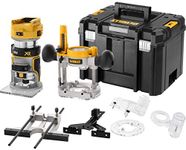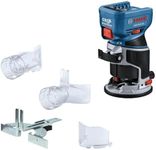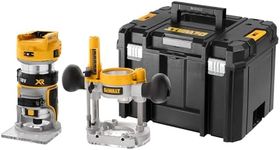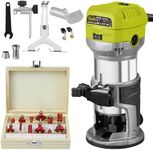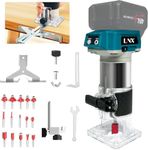Buying Guide for the Best Cordless Routers
Cordless routers are versatile tools that provide the freedom to work without being tethered to a power outlet. They are ideal for woodworking projects, allowing for precision and ease of movement. When choosing a cordless router, it's important to consider the specific needs of your projects, such as the type of materials you'll be working with and the level of precision required. Understanding the key specifications will help you select a router that best fits your needs.Battery VoltageBattery voltage in a cordless router determines the power and performance of the tool. Higher voltage typically means more power, which is important for cutting through tougher materials or for more demanding tasks. Routers generally come in voltages ranging from 12V to 20V or more. If you are working on heavy-duty projects or need longer runtime, a higher voltage battery would be beneficial. For lighter tasks or occasional use, a lower voltage might suffice, offering a lighter and more manageable tool.
RPM (Revolutions Per Minute)RPM indicates how fast the router bit spins. A higher RPM can provide a smoother finish and is better for fine, detailed work. Cordless routers typically offer RPMs ranging from 10,000 to 30,000. If you are working with softer woods or need a finer finish, a higher RPM is preferable. For harder materials or rougher cuts, a lower RPM might be adequate. Consider the type of work you will be doing most often to determine the right RPM range for you.
Collet SizeThe collet size determines the diameter of the router bits that can be used with the tool. Common sizes are 1/4 inch and 1/2 inch. A 1/4 inch collet is suitable for lighter, more detailed work, while a 1/2 inch collet can handle larger bits for more substantial cuts. If you plan to do a variety of tasks, a router that accommodates both sizes might be the most versatile choice.
Base TypeCordless routers can come with different base types, such as fixed or plunge bases. A fixed base is ideal for edge work and tasks where the depth of cut is consistent. A plunge base allows for more versatility, enabling you to start cutting in the middle of a workpiece. If your projects require varied depth cuts or more intricate work, a plunge base might be more suitable. For straightforward edge work, a fixed base could be sufficient.
Ergonomics and WeightThe ergonomics and weight of a cordless router affect how comfortable it is to use, especially for extended periods. A lighter router is easier to handle and maneuver, which is important for precision work. However, a heavier router might offer more stability. Consider how long you will be using the router and the type of work you will be doing to determine the best balance between weight and comfort.
Dust CollectionDust collection is an important feature for maintaining a clean work environment and ensuring visibility while working. Some routers come with built-in dust collection systems or attachments for external vacuums. If you are working in a small or enclosed space, or if you prioritize cleanliness, look for a router with effective dust collection capabilities. This feature can also help prolong the life of the tool by reducing dust buildup.
